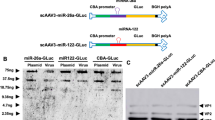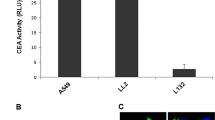Abstract
Adenoviral vectors are widely used in cancer gene therapy. After systemic administration however, the majority of the virus homes to the liver and the expressed transgene may cause hepatotoxicity. To restrict transgene expression to tumor cells, tumor- or tissue-specific promoters are utilized. The tumor antigen epithelial glycoprotein-2 (EGP-2), also known as Ep-CAM, is expressed in many cancers from different epithelial origins. In this study, the EGP-2 promoter was shown to restrict the expression of luciferase and thymidine kinase in an adenoviral context in different cell lines. In vivo, the EGP-2 promoter mediated efficient expression of luciferase in tumors but showed a 3-log lower activity in liver tissue when compared with the cytomegalovirus (CMV) promoter. Similarly, the EGP-2 promoter mediated specific cell killing after ganciclovir treatment in EGP-2-positive cells. Moreover, in vivo, this treatment regiment did not cause any rise in the liver enzymes aspartate aminotransferase (ASAT) and alanine aminotransferase (ALAT), demonstrating absence of liver toxicity. In contrast, CMV-mediated expression of thymidine kinase in combination with ganciclovir treatment resulted in high ASAT and ALAT values. This study demonstrates the value of the EGP-2 promoter to restrict transgene expression to a broad range of tumor types, thereby preventing liver toxicity.
This is a preview of subscription content, access via your institution
Access options
Subscribe to this journal
Receive 12 print issues and online access
$259.00 per year
only $21.58 per issue
Buy this article
- Purchase on Springer Link
- Instant access to full article PDF
Prices may be subject to local taxes which are calculated during checkout






Similar content being viewed by others
References
Sandmair AM, Loimas S, Puranen P, Immonen A, Kossila M, Puranen M et al. Thymidine kinase gene therapy for human malignant glioma, using replication-deficient retroviruses or adenoviruses. Hum Gene Ther 2000; 11: 2197–2205.
Immonen A, Vapalahti M, Tyynela K, Hurskainen H, Sandmair A, Vanninen R et al. AdvHSV-tk gene therapy with intravenous ganciclovir improves survival in human malignant glioma: a randomised, controlled study. Mol Ther 2004; 10: 967–972.
Alemany R, Suzuki K, Curiel DT . Blood clearance rates of adenovirus type 5 in mice. J Gen Virol 2000; 81: 2605–2609.
van der Eb MM, Cramer SJ, Vergouwe Y, Schagen FH, van Krieken JH, van der Eb AJ et al. Severe hepatic dysfunction after adenovirus-mediated transfer of the herpes simplex virus thymidine kinase gene and ganciclovir administration. Gene Therapy 1998; 5: 451–458.
Yamamoto M, Alemany R, Adachi Y, Grizzle WE, Curiel DT . Characterization of the cyclooxygenase-2 promoter in an adenoviral vector and its application for the mitigation of toxicity in suicide gene therapy of gastrointestinal cancers. Mol Ther 2001; 3: 385–394.
Glasgow JN, Bauerschmitz GJ, Curiel DT, Hemminki A . Transductional and transcriptional targeting of adenovirus for clinical applications. Curr Gene Ther 2004; 4: 1–14.
Nettelbeck DM, Jerome V, Muller R . Gene therapy: designer promoters for tumour targeting. Trends Genet 2000; 16: 174–181.
Anderson LM, Swaminathan S, Zackon I, Tajuddin AK, Thimmapaya B, Weitzman SA . Adenovirus-mediated tissue-targeted expression of the HSVtk gene for the treatment of breast cancer. Gene Therapy 1999; 6: 854–864.
Lee SJ, Kim HS, Yu R, Lee K, Gardner TA, Jung C et al. Novel prostate-specific promoter derived from PSA and PSMA enhancers. Mol Ther 2002; 6: 415–421.
Gotoh A, Ko SC, Shirakawa T, Cheon J, Kao C, Miyamoto T et al. Development of prostate-specific antigen promoter-based gene therapy for androgen-independent human prostate cancer. J Urol 1998; 160: 220–229.
Siders WM, Halloran PJ, Fenton RG . Melanoma-specific cytotoxicity induced by a tyrosinase promoter-enhancer/herpes simplex virus thymidine kinase adenovirus. Cancer Gene Ther 1998; 5: 281–291.
McLaughlin PM, Trzpis M, Kroesen BJ, Helfrich W, Terpstra P, Dokter WH et al. Use of the EGP-2/Ep-CAM promoter for targeted expression of heterologous genes in carcinoma derived cell lines. Cancer Gene Ther 2004; 11: 603–612.
Balzar M, Winter MJ, de Boer CJ, Litvinov SV . The biology of the 17-1A antigen (Ep-CAM). J Mol Med 1999; 77: 699–712.
Winter MJ, Nagtegaal ID, van Krieken JH, Litvinov SV . The epithelial cell adhesion molecule (Ep-CAM) as a morphoregulatory molecule is a tool in surgical pathology. Am J Pathol 2003; 163: 2139–2148.
Punt CJ, Nagy A, Douillard JY, Figer A, Skovsgaard T, Monson J et al. Edrecolomab alone or in combination with fluorouracil and folinic acid in the adjuvant treatment of stage III colon cancer: a randomised study. Lancet 2002; 360: 671–677.
de Boer CJ, van Krieken JH, Janssen-van Rhijn CM, Litvinov SV . Expression of Ep-CAM in normal, regenerating, metaplastic, and neoplastic liver. J Pathol 1999; 188: 201–206.
Bett AJ, Prevec L, Graham FL . Packaging capacity and stability of human adenovirus type 5 vectors. J Virol 1993; 67: 5911–5921.
Gires O, Eskofier S, Lang S, Zeidler R, Munz M . Cloning and characterisation of a 1.1 kb fragment of the carcinoma-associated epithelial cell adhesion molecule promoter. Anticancer Res 2003; 23: 3255–3261.
Yamamoto M, Davydova J, Takayama K, Alemany R, Curiel DT . Transcription initiation activity of adenovirus left-end sequence in adenovirus vectors with e1 deleted. J Virol 2003; 77: 1633–1637.
Black ME, Kokoris MS, Sabo P . Herpes simplex virus-1 thymidine kinase mutants created by semi-random sequence mutagenesis improve prodrug-mediated tumor cell killing. Cancer Res 2001; 61: 3022–3026.
Wiewrodt R, Amin K, Kiefer M, Jovanovic VP, Kapoor V, Force S et al. Adenovirus-mediated gene transfer of enhanced herpes simplex virus thymidine kinase mutants improves prodrug-mediated tumor cell killing. Cancer Gene Ther 2003; 10: 353–364.
de Leij L, Postmus PE, Buys CH, Elema JD, Ramaekers F, Poppema S et al. Characterization of three new variant type cell lines derived from small cell carcinoma of the lung. Cancer Res 1985; 45: 6024–6033.
Heideman DA, Snijders PJ, Craanen ME, Bloemena E, Meijer CJ, Meuwissen SG et al. Selective gene delivery toward gastric and esophageal adenocarcinoma cells via EpCAM-targeted adenoviral vectors. Cancer Gene Ther 2001; 8: 342–351.
Bijl J, van Oostveen JW, Kreike M, Rieger E, van der Raaij-Helmer LM, Walboomers JM et al. Expression of HOXC4, HOXC5, and HOXC6 in human lymphoid cell lines, leukemias, and benign and malignant lymphoid tissue. Blood 1996; 87: 1737–1745.
He TC, Zhou S, da Costa LT, Yu J, Kinzler KW, Vogelstein B . A simplified system for generating recombinant adenoviruses. Proc Natl Acad Sci USA 1998; 95: 2509–2514.
McLaughlin PM, Harmsen MC, Dokter WH, Kroesen BJ, van der MH, Brinker MG et al. The epithelial glycoprotein 2 (EGP-2) promoter-driven epithelial-specific expression of EGP-2 in transgenic mice: a new model to study carcinoma-directed immunotherapy. Cancer Res 2001; 61: 4105–4111.
Barker SD, Coolidge CJ, Kanerva A, Hakkarainen T, Yamamoto M, Liu B et al. The secretory leukoprotease inhibitor (SLPI) promoter for ovarian cancer gene therapy. J Gene Med 2003; 5: 300–310.
Casado E, Gomez-Navarro J, Yamamoto M, Adachi Y, Coolidge CJ, Arafat WO et al. Strategies to accomplish targeted expression of transgenes in ovarian cancer for molecular therapeutic applications. Clin Cancer Res 2001; 7: 2496–2504.
Wesseling JG, Yamamoto M, Adachi Y, Bosma PJ, van Wijland M, Blackwell JL et al. Midkine and cyclooxygenase-2 promoters are promising for adenoviral vector gene delivery of pancreatic carcinoma. Cancer Gene Ther 2001; 8: 990–996.
Haviv YS, Curiel DT . Conditional gene targeting for cancer gene therapy. Adv Drug Deliv Rev 2001; 53: 135–154.
Zhu ZB, Makhija SK, Lu B, Wang M, Kaliberova L, Liu B et al. Transcriptional targeting of tumors with a novel tumor-specific survivin promoter. Cancer Gene Ther 2004; 11: 256–262.
Peng XY, Won JH, Rutherford T, Fujii T, Zelterman D, Pizzorno G et al. The use of the L-plastin promoter for adenoviral-mediated, tumor-specific gene expression in ovarian and bladder cancer cell lines. Cancer Res 2001; 61: 4405–4413.
Momburg F, Moldenhauer G, Hammerling GJ, Moller P . Immunohistochemical study of the expression of a Mr 34,000 human epithelium-specific surface glycoprotein in normal and malignant tissues. Cancer Res 1987; 47: 2883–2891.
Steinwaerder DS, Lieber A . Insulation from viral transcriptional regulatory elements improves inducible transgene expression from adenovirus vectors in vitro and in vivo. Gene Therapy 2000; 7: 556–567.
Vassaux G, Hurst HC, Lemoine NR . Insulation of a conditionally expressed transgene in an adenoviral vector. Gene Therapy 1999; 6: 1192–1197.
Acknowledgements
This work was supported by NIH Grant R03 AR46864, NIH Grant R01 CA94084, NIH Grant R01 DK63615 (to MY) and by NIH Grant R01 CA86881 (to DTC). We are grateful to DAM Heideman from the VUMC, Amsterdam, The Netherlands for advice on RT-PCR and to B Dontje and A van Loenen-Weemaes from the RUG, Groningen, The Netherlands for their help with the animal experiments.
Author information
Authors and Affiliations
Corresponding author
Rights and permissions
About this article
Cite this article
Gommans, W., van Eert, S., McLaughlin, P. et al. The carcinoma-specific epithelial glycoprotein-2 promoter controls efficient and selective gene expression in an adenoviral context. Cancer Gene Ther 13, 150–158 (2006). https://doi.org/10.1038/sj.cgt.7700882
Received:
Revised:
Accepted:
Published:
Issue Date:
DOI: https://doi.org/10.1038/sj.cgt.7700882



